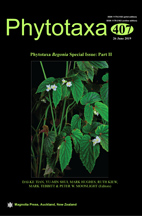Abstract
The pantropically distributed Begonia (Begoniaceae) is one of the most species-rich genera. Philippines is one of the diversity centers of Southeast Asian Begonia. In our 2012 field survey, three species of Begonia section Petermannia were collected in Barangay Sagubo, Municipality of Kapangan, Province of Benguet in the northern Luzon Island, Philippines. Our study on literatures and herbarium specimens suggests that these collections consist of B. crispipila, an unknown new species hereby we named B. balangcodiae, and the natural hybrid between them. Molecular analyses confirm that the former contributed the maternal genome while the latter provided the paternal genome. We name the natural hybrid B. × kapangan, which is the first natural hybrid reported in sect. Petermannia.

